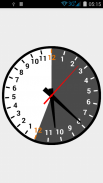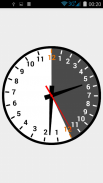




Jewish Clock

Descripción de Jewish Clock
Jewish Clock is a 24 hour clock which attempts to visualize the concepts of the clock that is used in Jewish law: Shaot Zmaniyot (or Zmanim).
The basic idea is that certain daily deadlines were defined as portions of the day. For example, according to Jewish law, the latest time one can pray the morning prayer, Shacharit, is when a third of the day passed, or in other words, 4 out of the 12 hours of the day have passed.
The modern way of using charts which translate the laws defined by Shaot Zmaniyot into our familiar clock, are not needed anymore when using this clock. Shacharit deadline is alway at 4. Shabbat, or any new day for that matter, always start at 12.
In particular, the clock divides the day, starting at sunrise, and ending at sunset, into 12 equal parts, which are each called one day hour. The night is divided in the same manner.
An important observation is that day lengths keep on changing, as do the lengths of the nights. In the summer the days are longer, and they leave much less for the night, and in the winter vice versa.
A non trivial way of showing the fact that we have more day time during the summer, is showing the time moving slower during summer days! the clock ticks the same number of times as usual: 60 seconds * 60 minutes * 12 hours a day. But those seconds are longer! So the clock ticks slower.
Location. Sunrise and sunset are strongly tied to ones location. That's why Jewish Clock needs to know the device's location before showing the time. In a device with no location capabilities, Jewish Clock can not function.
Enjoy,
Yehuda Adler
yehuda.adler@gmail.com
El Reloj judío es un reloj de 24 horas que intenta visualizar los conceptos del reloj que se utiliza en la ley judía: Shaot Zmaniyot (o Zmanim).
La idea básica es que ciertos plazos diarios se definieron como partes del día. Por ejemplo, según la ley judía, la última vez que se puede rezar la oración de la mañana, Shacharit, es cuando ha pasado un tercio del día, o en otras palabras, 4 de las 12 horas del día han pasado.
La forma moderna de usar gráficos que traducen las leyes definidas por Shaot Zmaniyot en nuestro reloj familiar, ya no son necesarias cuando se usa este reloj. La fecha límite de Shacharit es siempre a las 4. Shabat, o cualquier nuevo día, comience siempre a las 12.
En particular, el reloj divide el día, comenzando a la salida del sol y terminando al atardecer, en 12 partes iguales, cada una de las cuales se llama hora de un día. La noche se divide de la misma manera.
Una observación importante es que la duración del día sigue cambiando, al igual que la duración de las noches. En el verano los días son más largos, y dejan mucho menos para la noche, y en el invierno, viceversa.
¡Una forma no trivial de mostrar el hecho de que tenemos más tiempo durante el verano, es mostrar que la hora se mueve más lentamente durante los días de verano! el reloj marca el mismo número de veces que lo habitual: 60 segundos * 60 minutos * 12 horas al día. ¡Pero esos segundos son más largos! Así que el reloj corre más lento.
Ubicación. El amanecer y el atardecer están fuertemente ligados a la ubicación de uno. Es por eso que Jewish Clock necesita conocer la ubicación del dispositivo antes de mostrar la hora. En un dispositivo sin capacidad de ubicación, el Reloj judío no puede funcionar.
Disfrutar,
Yehuda Adler
yehuda.adler@gmail.com


























